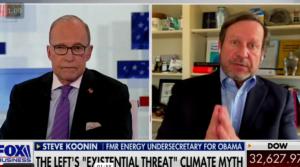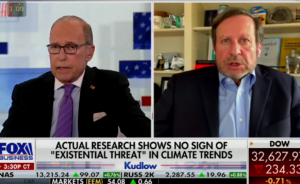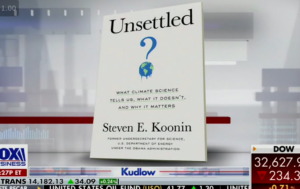Steve Koonin joins FBN’s ‘Kudlow’ 3.19.21, Part 1
Theoretical physicist Dr. Steve Koonin was undersecretary of energy for science during President Obama’s first term and is director of the Center for Urban Science and Progress at New York University.
Steve Koonin joins FBN’s ‘Kudlow’ 3.19.21, Part 2
Fox Business Channel – Broadcast March 19, 2021
Select Transcript:
Physicist Dr. Steve Koonin: First of all, I think everybody agrees that the globe has warmed about a degree from 1900 until the present. And that warming is due to some combination of human influences and natural influences. But beyond that, almost no severe weather event shows any detectable trend. There are no long-term trends in droughts or floods around the globe — in severe weather events like thunderstorms.
Sea level is rising at the spectacular rate of one foot per century and was doing it at about the same rate 80 years ago. In the US, record high temperatures are no more frequent than they were in the 1900s. I can go on and on. No detectable human influences on hurricanes. This is not Steve talking, this is what’s in those reports often explicitly, but sometimes a little bit obscured and you got to read closely to find it.
Larry Kudlow: Actually I want you to go on and on, I’ll give you 45 or 50 minutes on the show because this is so important. All these people, you know they got the memo ‘existential threat’, you’re saying factually it’s not true.
#
Flashback 2020: Physicist Steven Koonin: ‘A Deceptive New Report on Climate’ – The report ominously notes that while global sea level rose an average 0.05 inch a year during most of the 20th century, it has risen at about twice that rate since 1993. But it fails to mention that the rate fluctuated by comparable amounts several times during the 20th century. The same research papers the report cites show that recent rates are statistically indistinguishable from peak rates earlier in the 20th century, when human influences on the climate were much smaller. The report thus misleads by omission…This isn’t the only example of highlighting a recent trend but failing to place it in complete historical context.
The report’s executive summary declares that U.S. heat waves have become more common since the mid-1960s, although acknowledging the 1930s Dust Bowl as the peak period for extreme heat. These deficiencies in the new climate report are typical of many others that set the report’s tone. Consider the different perception that results from “sea level is rising no more rapidly than it did in 1940” instead of “sea level rise has accelerated in recent decades,” or from “heat waves are no more common now than they were in 1900” versus “heat waves have become more frequent since 1960.” Both statements in each pair are true, but each alone fails to tell the full story.






